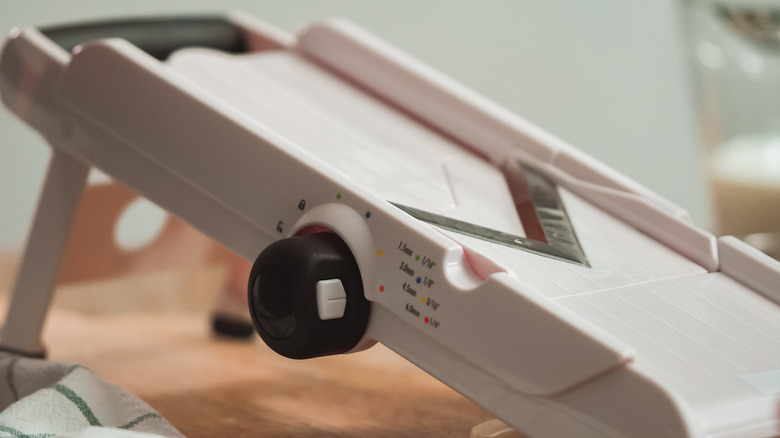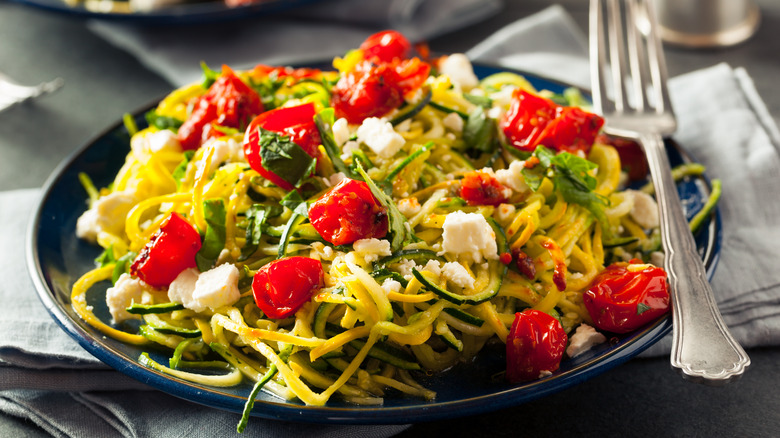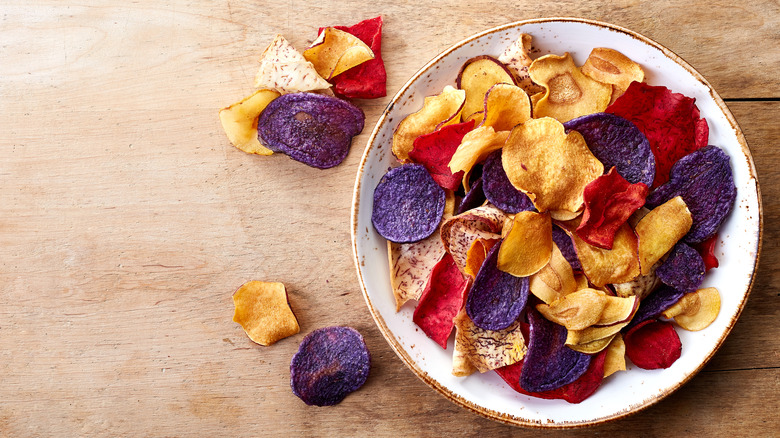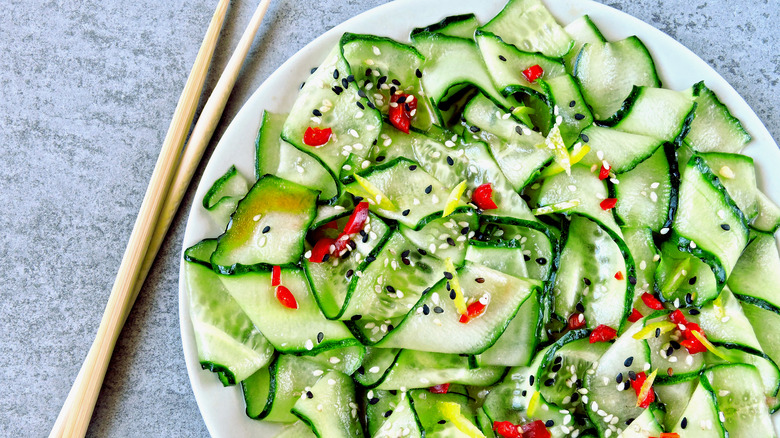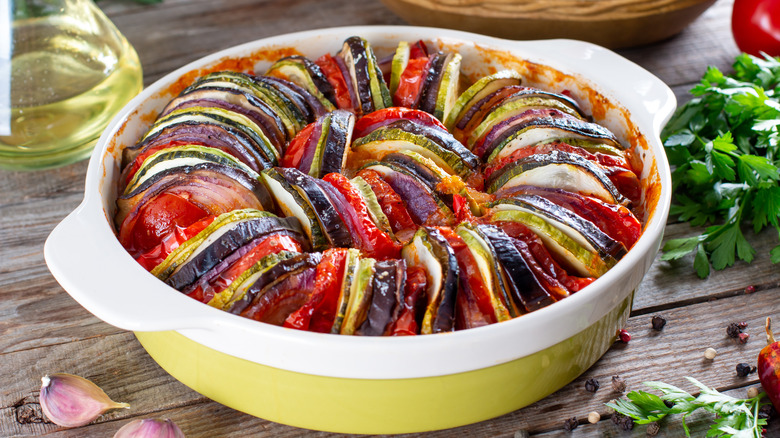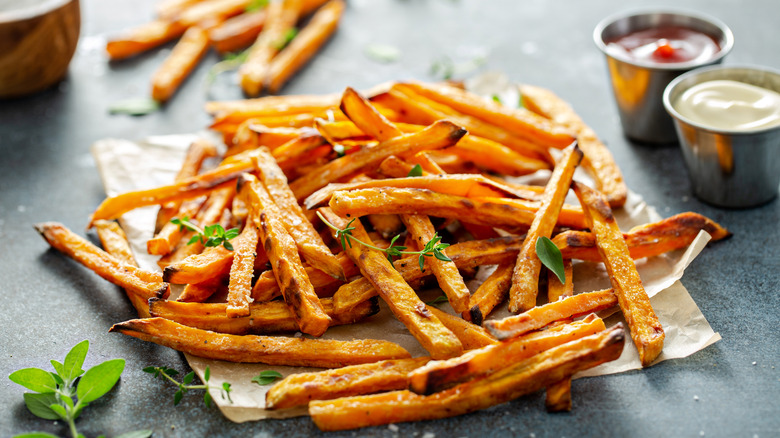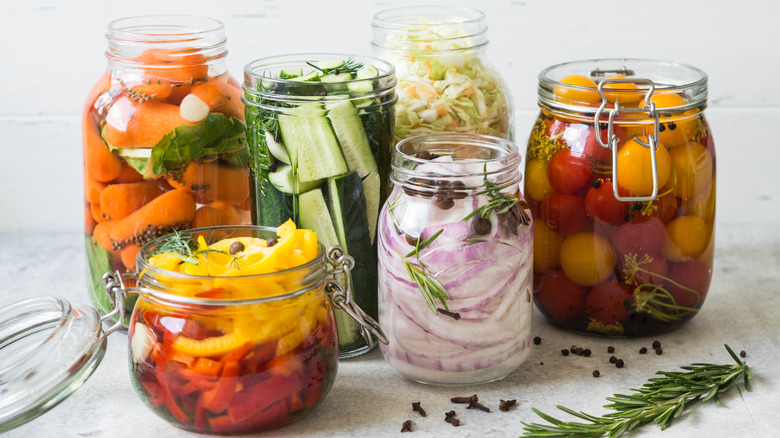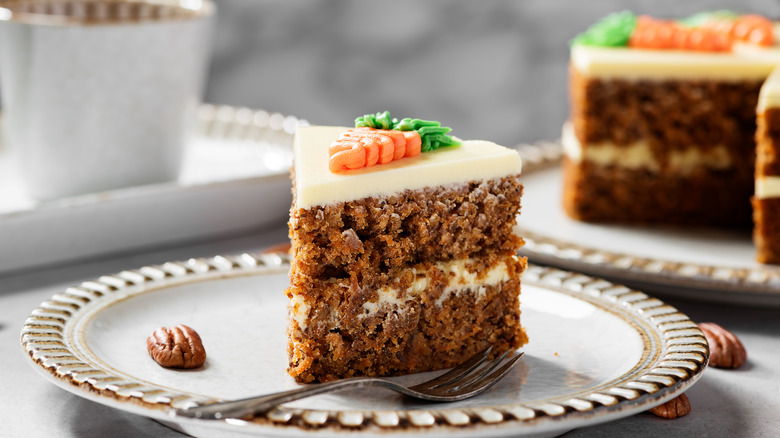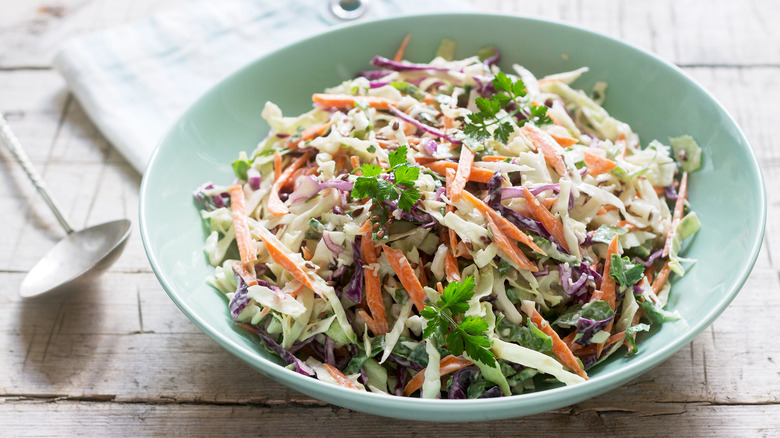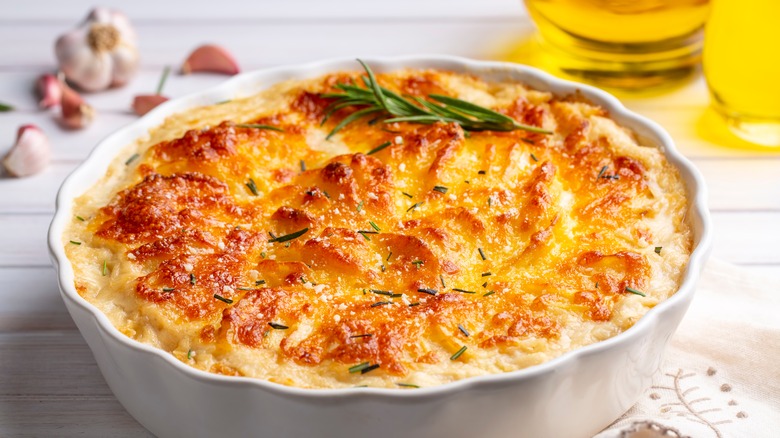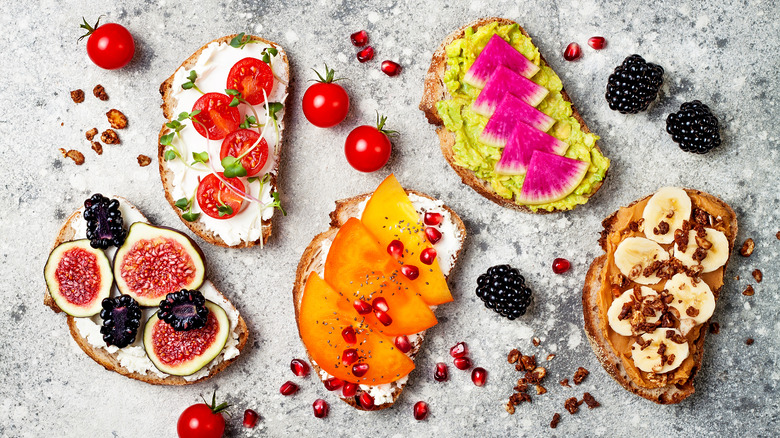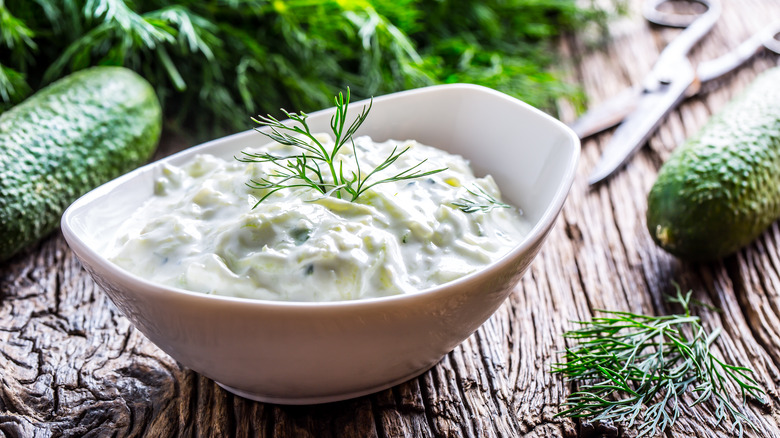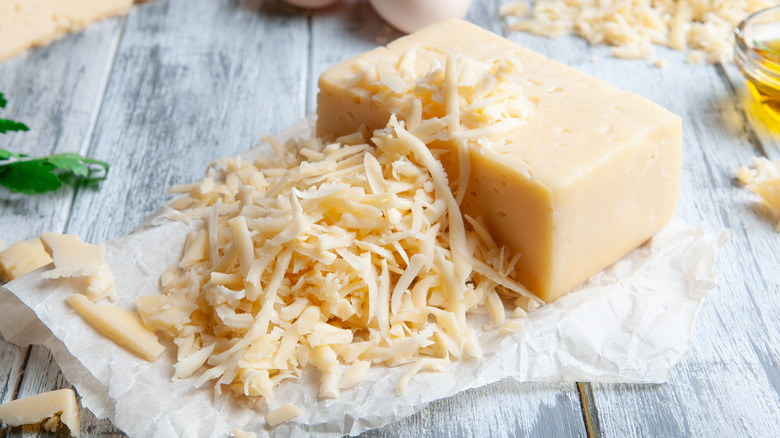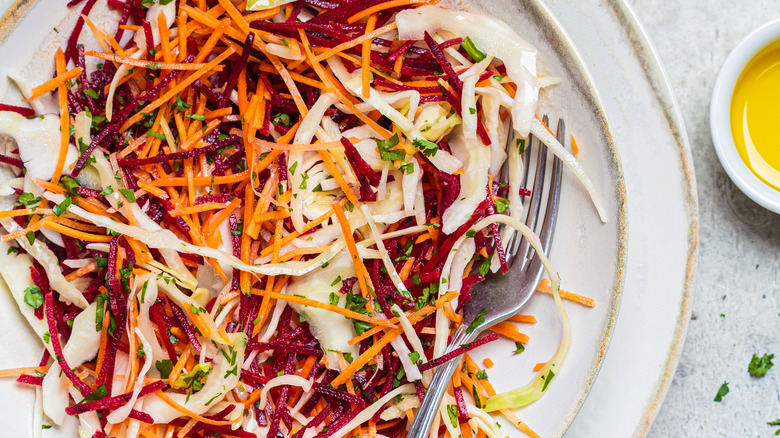The Absolute Best Uses For Your Mandoline Slicer
Let's face it, some of us don't like chopping. It's by far the least exciting part of the cooking process, and prep work generally takes up a lot of valuable time. According to The U.S. Department of Agriculture, the average American spends 37 minutes on food preparation and cleanup per day. Although pro-chefs seem to make quick work of the process and magically maintain precision, the same can't be said for the average home cook. Enter the mandoline slicer: The kitchen gadget that makes chopping, slicing, and dicing quick, fun, and easy.
Mandoline slicer styles range from basic hand-held tools to full-size kitchen gadgets equipped with a wide variety of different blades that can be swapped out to accomplish a range of tasks. The most rudimentary mandoline slicers will have a nonremovable straight blade, which is great for slicing vegetables to a consistent thickness. On the other hand, full-sized mandoline slicers will allow you to slice, grate, julienne, and even waffle-cut vegetables with different blades.
Maybe you already have a mandoline relegated to a corner of your kitchen and left unused. Or, maybe, you want to know how they can be used before you make the decision to buy. Well, if you thought that a mandoline is only good for slicing carrots and cucumber, think again. We'll showcase a series of scrumptious savory and sweet recipes that explore the best uses for your mandoline slicer.
Zoodles
Zucchini noodles are a tasty and healthy alternative to traditional pasta. Also known as 'zoodles', this pasta alternative is an incredible option for anyone with gluten-free dietary requirements. That's not their only selling point though — zucchini noodles are incredibly fast and easy to prepare, but also extremely versatile. More than just a fad, zoodles will soon be part of your weekly recipe rotation.
How you cut your noodles will depend on the pasta you'll be replicating. For lasagna sheets, use the ⅛-inch straight blade on your mandoline to make robust, long ribbons. To recreate wide noodles like Pappardelle or Fettuccine, manually cut the long ribbons into strips. Alternatively, use the julienne attachment to make Spaghetti style noodles, which are perfect raw or lightly sautéed. Add basil pesto or garlicky brown butter for a light yet unctuous dish.
Because zucchini is 94% water, the main thing to avoid is soggy noodles. An easy solution is to toss your raw noodles in salt to draw out the excess moisture through the process of osmosis (via The Los Angeles Times). According to expert Thomas Keller, leaving your salted zucchini to sit for 10 minutes and then blotting with a dry paper towel to absorb the extracted water helps maintain the texture of the zucchini once cooked. You can use these noodles directly in your recipes or line a large storage container with a paper towel, add your zucchini noodles, and store them in the refrigerator for up to three days.
Vegetable chips
Chips are everyone's favorite snack food. They're crispy, crunchy, and addictive. While making chips at home may seem like a lot of work, with a mandoline slicer it's quick and easy. In under 10 minutes, you can have a bowlful of freshly colorful and healthy baked vegetable chips with minimum effort. Start by selecting a variety of root vegetables. We recommend beetroot, parsnips, carrots, and sweet potato. Taro and yuca root are more unusual suggestions, but they're well worth seeking out for their distinctive potato-like crunch.
Whether you peel your vegetable chips or not is a matter of personal preference. As per Healthline, vegetable peel typically contains high amounts of beneficial vitamins and minerals. Electing to not peel your vegetables makes prep work a lot easier and faster. If you choose this option, simply give your vegetables a thorough scrub under running water, then pat dry (via CDC).
To make standard vegetable chips, opt for the 1/16-inch slicing blade of your mandoline. If your mandoline comes equipped with a wavy blade, you can experiment with crinkle-cut vegetable chips too. Once cut, use a paper towel to pat any excess moisture from the sliced vegetables. This will ensure they crisp up beautifully. Once cooked, you can explore the really fun part — seasoning. Either opt for a classic choice like kosher salt, garlic powder, and onion powder, or spice it up with some cayenne pepper, smoked paprika powder, curry powder, or fennel seeds.
Asian cucumber salad
If you're looking for a healthy, cooling, and an astoundingly simple side dish to serve, you've found it. Imagine thinly sliced cucumbers coated with nutty sesame oil; acidic rice vinegar, punchy chili flakes, and the deep umami of soy sauce. Add some sweet honey (or agave) with finely minced garlic and ginger to the mix, toss it well, and you're ready to dig in.
Thin-skinned and seedless cucumber varieties like English or Persian work best for this recipe. The bitter flavor profile of cucumber originates from the seeds (via Organic Facts), hence why many people favor English cucumbers. Use the mandoline slicer to make delicate ribbons or thin rounds from your cucumbers.
Despite its simplicity, Asian cucumber salad is loaded with balanced flavors that together perfectly create a dish that is refreshing, spicy, and tasty. We suggest that you explore different flavor combinations to create your unique spin on the recipe. For example, a Thai-style smashed cucumber salad recipe with toasted sesame oil or peanuts to vary the texture and add extra nutrition.
Ratatouille
Ratatouille may have been made famous by an animated Pixar film of the same name, but the origins of the dish are much older. Ratatouille is a cozy, comforting, and hearty recipe hailing from Provençe in the South of France, as reported by Gambero Rosso. The dish was invented by resourceful farmers who needed a way to use up the last of the summer seasons vegetables, says the site.
The base of any great ratatouille recipe is a tomato sauce peppered with aromatics like onion, garlic, pepper, basil, and thyme. Slather the sauce onto a circular baking pan and arrange your vegetables in an alternating pattern spiraling inward for great visual effect. Traditionally, you'll want to use fresh eggplant, bell peppers, zucchini, and yellow squash. Cut using the ⅛-inch thick straight blade on your mandoline.
The result is a healthy stew that tastes glorious either mopped up with crusty bread or served atop a pile of steaming rice. It's perfect for meat-free Mondays or as an anytime vegan main.
Potato fries
Potato fries are one of the most beloved side dishes: burgers with fries, battered fish with fries, baked beans with fries, and mac and cheese with fries are all classic combinations. We're all used to perfectly cut and crispy potato fries, but it's hard to replicate that consistency at home. Say goodbye to fast food or frozen fries: A mandoline can make thick-cut fries, french fries, shoestring fries, or even waffle fries. As per Ontario Potatoes, Russet potatoes are the best variety for potato fries due to their high starch content and low moisture. However, Maris Piper is a good alternative –- or even sweet potatoes.
Use the ¼-inch square blade to cut McDonald's copycat french fries, or opt for the ⅛-inch julienne blade for ultra-thin shoestring fries. While the classic french fry shape combines a delightfully crunchy exterior with a soft and pillowy interior, shoestring fries are exclusively crispy. Waffles fries, on the other hand, will require a wavy blade. Rotate the potato 90 degrees between cuts to achieve the distinctive waffle-cut shape.
Pickled vegetables
Chilled, salty pickles are one of life's greatest pleasures. You can grab a jar from the refrigerator and dig right into a crunchy snack, add them to grilled cheese sandwiches, serve skewered atop burgers, mix into dips (dill pickle hummus, anyone?), add on the side of a vegan bean chili, or mop them up with Indian chana masala.
Quick refrigerator pickles are incredibly easy to make at home and a great way to preserve your favorite vegetables. Firstly, make a basic brine by heating vinegar, water, salt, and sugar. PennState Extension stresses that the standard vinegar for pickling should have 5% acidity, and white distilled vinegar is usually a great choice. Red onions, beetroot, carrots, zucchini, pickling cucumbers, radishes, and cabbage are all popular pickling vegetables. Use your mandoline slicer's ¼-inch straight blade for circular cuts (great for cucumbers and radishes), the straight blade (for onions), or the julienne blade (for carrots, zucchini, and more). Pack the vegetables tightly into clean glass jars, add aromatics, and pour over the hot brine.
Finally, leave the pickles to cool before refrigerating. Most homemade pickles can be stored in the refrigerator for up to three months, although Home Cook World emphasizes that you should avoid using your hands to take out the pickles, as it will reduce the shelf life.
Carrot cake
Carrot cake, in all its moist, dense, nutty, and spicy glory. That's right –- mandoline slicers can make desserts easy-breezy, too. As the star ingredient, freshly shredded carrots should always be used for carrot cake. When grating fresh carrots, you'll notice they contain extra moisture that the packaged variety lacks due to processing.
This is where your mandoline will come in really handy: Use the grater attachment to make quick work of grating your carrots. Employ the fine grater if you prefer your carrots to melt into the cake batter, or opt for the coarse grater if you would rather have distinctive pieces of carrot in your cake. To make a real showstopper, add some grated orange zest to your batter at this stage too — it pairs beautifully with the carrots and spices. Once mixed, pour the batter into your cake tins and bake for 30 minutes. As per King Arthur Baking, you'll know the cake is done when a toothpick comes out clean.
Coleslaw
Can you name a side dish that's more ubiquitous with barbeques, cookouts, potlucks, and parties than coleslaw? It's a recipe that perfectly balances luscious creaminess with crunchy bite, and yet we often overlook it. You may be surprised to know that coleslaw actually has its origins in ancient Rome, where cabbage was combined with vinegar, eggs, and spices to make a delicious side dish, according to NPR, while the modern dish as we know it was developed around the 17th or 18th centuries by Dutch settlers in New York.
While coleslaw has many variations for vegetables and dressing, according to The Guardian, it must contain cabbage. Experiment with white, red, napa, or savoy cabbages. Use the julienne cutting blade of your mandoline slicer to shred the cabbage, carrots, and red onions into uniform and crunchy slices.
For a basic coleslaw dressing, we recommend 1 cup of mayonnaise, 1 tablespoon each of honey and rice wine vinegar, and ⅛ teaspoon of both salt and ground black pepper. Mix into your shredded vegetables and chill in the fridge for at least an hour. Just before serving, stir through fresh herbs: dill, parsley or cilantro work well. You're ready to slather your new homemade coleslaw on burgers, salad bowls, or tacos.
Sliced potatoes
Most of us think of potatoes as a humble ingredient. Mashed potatoes, Irish potato cakes, and potato salad are homely and comforting. Conversely, French potato dishes are sophisticated, rich, buttery, and indulgent. Often made from very finely sliced potatoes cooked with copious amounts of butter, cream, or cheese, they're an ideal choice for festive sides. Moreover, you'll be excited to hear that a mandoline makes them easy-peasy!
Firstly, pommes Anna. This is a deceptively simple dish that only requires three ingredients: potatoes, butter, and salt. You'll want to use the ⅛-inch straight blade of your mandoline slicer to cut thin slivers of potato. Presentation is key for this dish, and the potatoes must be cut uniformly. Second, Potato au Gratin is guaranteed to get your taste buds tingling. This recipe is made by simmering sliced potatoes in milk, cream, and garlic before layering the potatoes in a baking dish and pouring the creamy broth over top. Again, you'll want to slice your potatoes ⅛-inch thick with your mandoline. Extravagant? Yes. And the pièce de résistance? Rich and salty grated gruyere melted on top.
Finally, scalloped potatoes. While potato au gratin should always contain cheese, scalloped potatoes traditionally don't (via Southern Living). Instead, they're topped with crispy breadcrumbs, contrasting with the gloriously tender, and creamy potatoes underneath. For this dish, we recommend a thicker-cut potato. Choose the ¼-inch straight blade of the mandoline for the best results.
Open Sandwiches
If you love eating a slice or two of hot toast slathered with creamy butter every morning, you're not alone. Yet why not spruce up your breakfast and add a little variety with a range of toppings? Your avocado toast would be even more Insta-worthy with a few slices of shaved radishes on top. If you don't like avocado (we can't relate!), no worries: Make a radish toast recipe by slathering your toast with butter and topping it with shaved radish.
Maybe you've got a sweet tooth. How about finely sliced apples sprinkled with cinnamon atop peanut butter-slathered toast? A fan of the classics? Try poached eggs on toast garnished with shaved asparagus, or toast spread with herby cream cheese, topped with salmon, and finished with ribbons of refreshing cucumber. The sky really is the limit, and a mandoline will make finely slicing those fiddly fruits and vegetables so much easier. For most fruits and vegetables, the ¼-inch or 1/8-inch straight blade will be perfect for the job.
Tzatziki
What are gyros without tzatziki? Would souvlaki taste the same without it? Tzatziki is a tangy, creamy, and garlicky yogurt-based dip hailing from Southeast Europe and the Middle East. You'll often find it drizzled over grilled meats, spread over pita, or served on alongside mezze dishes like spanakopita. At its core, tzatziki is a simple recipe. Thick yogurt (Greek yogurt is the go-to, although we posit homemade yogurt would work well too) combined with finely grated cucumber, garlic, lemon juice, salt, olive oil, and plenty of fresh mint.
If you select the right variety of cucumber, there should be no need to peel them. According to Leafy Place, there are almost 100 varieties of cucumber. However, when it comes to making tzatziki, there's a clear winner. Ina Garten says that you should use English cucumbers (otherwise known as Hothouse cucumbers) for your tzatziki due to their comparatively low moisture content and thin skins. Simply cut your cucumber in half and use the coarse grater attachment of your mandoline to make quick work of grating the cucumber. General consensus is that coarsely grated cucumber is preferred for tzatziki while finely grated cucumber melts away to insignificance, which makes for a less appealing result.
Finally, squeeze out the excess moisture. Unlike its predecessor raita, tzatziki should be thick and creamy (via Faraway Worlds), which is why both the variety of cucumber and the technique of removing excess moisture are so important.
Grated cheese
Did you know that the packaged pre-shredded cheese you buy from your grocery store actually contains added extras like potato starch, powder cellulose, and natamycin (via KCET)? These ingredients are primarily anti-clumping agents designed to improve the appeal of pre-shredded cheese, but they also affect its performance in recipes. As The Nibble points out, if you find yourself dining in an Italian restaurant the server will often grate the cheese directly onto your dish. That's because cheese really does taste best fresh! However, if you're looking for all the convenience of packaged, we've got a solution for that too.
To garnish foods like leek soup or mushroom risotto, shave your cheese using the mandoline slicers 1/16-inch straight blade. The thin strips of cheese will be effective in making any dish you serve look beautiful. To grate cheese for cooking into a dish, use your mandoline slicers grater attachment. They are often equipped with rough and fine grater attachments; the fine grater is recommended for hard cheeses like Parmesan, while the rough grater is effective for soft cheeses like Mozzarella in addition to harder varieties. You can use this grated cheese immediately or bag up your grated cheese and freeze it for up to two months (via Freeze It).
A final tip – according to The Washington Post, spritzing your mandoline slicer's grater attachment with cooking spray will make the cleanup much easier.
Shaved vegetable salad
Anyone who says salad is boring simply hasn't been eating the right salad. A shaved vegetable salad dressed with a tangy, sweet sauce and garnished with crumbled cheese and nuts? Heaven. Use whatever vegetables are in season. We love root vegetables like golden beets, carrots, and radishes for their vibrant color, intense flavor, and vast nutritional benefits. As per WebMD, root vegetables offer necessary antioxidants, are low in cholesterol, and make a healthy yet delectable option for a light lunch or dinner.
Begin by peeling your vegetables. Next, you can use the 1/16-inch straight blade of your mandoline slicer to cut wide ribbons. As an alternative, use the fine julienne attachment to make very thin strips from your vegetables. While the ribbons have a wider surface area for dressing to coat, the julienned strips make for a crunchier, crisper finish.
The only thing left to do is toss in the piquant dressing and garnish with crumbled cheese, nuts, and fresh herbs. Go ahead and serve this salad as a meat-free main course. To make it a little more substantial, add some cajun grilled salmon, herbed falafels, or a roasted rack of lamb.
